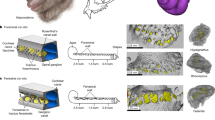Abstract
The stereocilia of the Organ of Corti in 4 different echolocating bats, Myotis adversus, Murina leucogaster, Nyctalus plancyi (Nyctalus velutinus), and Rhinolophus ferrumequinum were observed by using scanning electron microscopy (SEM). Stereocilia lengths were estimated for comparison with those of non-echolocating mammals. The specialized lengths of outer hair cells (OHC) stereocilia in echolocating bats were shorter than those of non-echolocating mammals. The specialized lengths of inner hair cells (IHC) stereocilia were longer than those of outer hair cells stereocilia in the Organ of Corti of echolocating bats. These characteristics of the auditory stereocilia length of echolocating bats represent the fine architecture of the electromotility process, helping to adapt to high frequency sound and echolocation.
Similar content being viewed by others
References
Brownell W E, Spector A A, Raphael R M, et al. Micro-and nanomechanics of the cochlear outer hair cell. Annu Rev Biomed Eng, 2001, 3: 169–194
Köppl C, Authier S. Quantitative anatomical basis for a model of micromechanical tuning in the Tokay gecko, (Gekko gecko). Hearing Res, 1995, 82(1): 14–25
Fettiplace R, Fuchs P A. Mechanisms of hair cell tuning. Annu Rev Physiol, 1999, 61: 809–834
Tilney I G, Saunders J C. Actin filaments, stereocilia and hair cells of the bird cochlea. I Length, width and distribution of stereocilia of each hair cell are related to the position of the hair cell on the cochlea. J Cell Biol, 1983, 96: 807–821
Langer M G, Koitschev A, Haase H, et al. Mechanical stimulation of individual stereocilia of living cochlear hair cells by atomic force microscopy. Ultramicroscopy, 2000, 82: 269–278
Lim D J. Functional structure of the organ of Corti: A review. Hearing Res, 1986, 22: 117–146
Lenoir M, Ripoll C, Vago P. Structural and ultrastructural aspects of isolated immature cochlca outer hair cell maintained in short-term culture. Hearing Res, 1995, 88(1–2): 169–180
Saunders J C, Garfinkle T J. Peripheral anatomy and physiology I. In: Willott J F, ed. The Auditory Psychobiology of the Mouse. Illinois: Springfield, 1983. 131–168
Wright A. Dimensions of the cochlea stereocilia in man and the guinea pig. Hearing Res, 1984, 13(1): 89–98
Vater M, Lenoir M, Pujol R. Ultrastructure of the horseshoe bat’s organ of Corti. I. Scanning electron microscopy. J Comp Neuro, 1992, 318: 367–379
Vater M, Lenoir M, Pujol R. Ultrastructure of the horseshoe bat’s organ of Corti. II. Scanning electron microscopy. J Comp Neuro, 1992, 318: 380–391
Vater M, Kössl M. Further studies on the mechanics of the cochlear partition in the mustached bat. I. Ultrastructural observations on the tectorial membrane and its attachments. Hearing Res, 1996, 94(1–2): 63–77
Kössl M, Foeller E, Drexl M, et al. Postnatal development of cochlear function in the mustached bat, Pteronotus parnellii. J Neurophysiol, 2003, 90: 2261–2273
Dannhof B J, Bruns V. The organ of Corti in the bat Hipposideros bicolor. Hearing Res, 1991, 53(2): 253–268
Vater M, Siefer W. The cochlea of Tadarida brasiliensis: Specialized functional organization in a generalized bat. Hearing Res, 1995, 91(1–2): 178–195
Simmons N B. In: Wilson D E, Reeder D M, eds. Order Chiroptera in Mammal Species of the World: A Taxonomic and Geographic Reference. 3rd ed. Baltimore: The Johns Hopkins University Press, 2005
Sun J H, Wang Q J, Jiang S C. Cochlca Scanning Electron Microscopy Atlas. Beijing: People’s Military Medical Press, 2006
Bauer C A, Brozoski T J. Cochlear structure and function after round window application of ototoxins. Hearing Res, 2005, 201(1–2): 121–131
Fettiplace R, Fuchs P A. Mechanisms of hair cell tuning. Annu Rev Physiol, 1999, 61: 809–834
John D A. Bats Biology and Behaviour. New York. Oxford University Press, 1996. 83–85
Ulfendahl M, Khanna S M, Fridberger A, et al. Mechanical response characteristics of the hearing organ in the low-frequency regions of the cochlea. J Neurophysiol, 1996, 76(6): 3850–3862
Heffner R S, Koay G, Heffner H E. Hearing in large (Eidolon helvum) and small (Cynopterus brachyotis) non-ccholocating fruit bats. Hearing Res, 2006, 21: 17–25
Zhang S Y, Feng J, Li Z X, et al. Comparison of the echolocation signals in three species of bats at fly. Acta Zoologica Sinica, 1999, 45(4), 385–389
Bruns V, Goldbach M. Hair cells and tectorial membrane in the cochlea of the greater horseshoe bat. Ana Embryol, 1980, 161(1): 51–63
Schneider M E, Belyantseva I A, Azevedo R B. et al. Rapid renewal of auditory hair bundles. Nature, 2002, 418: 837–838
Hudspeth A J, Corey D P. Sensitivity, polarity and conductance change in the response of vertebrate hair cells to controlled mechanical stimuli. Proc Natl Acad Sci USA, 1977, 74: 2407–2411
Liberman M C, Gao J, He D Z Z, et al. Prestin is required for electromotility of the outer hair cell and for the cochlear amplifier. Nature, 2002, 419(6904): 300–304
Jia S, He D Z Z. Motility-associated hair-bundle motion in mammalian outer hair cells. Nat Neurosci, 2005, 8: 1028–1034
Fettiplace R, Hackney C M. The sensory and motor roles of auditory hair cells. Nat Rev Neurosci, 2006, 7: 19–29
Raphael Y, Altschuler R A. Structure and innervation of the cochlea. Brain Res Bull, 2003, 60: 397–422
Author information
Authors and Affiliations
Corresponding authors
Additional information
These authors contributed equally to this work
Supported by the National Natural Science Foundation of China (Grant No. 30430120) and Foundation of President of the Chinese Academy of Sciences
Rights and permissions
About this article
Cite this article
Yao, Q., Zeng, J., Zheng, Y. et al. Characteristics of echolocating bats’ auditory stereocilia length, compared with other mammals. SCI CHINA SER C 50, 492–496 (2007). https://doi.org/10.1007/s11427-007-0055-8
Received:
Accepted:
Issue Date:
DOI: https://doi.org/10.1007/s11427-007-0055-8




